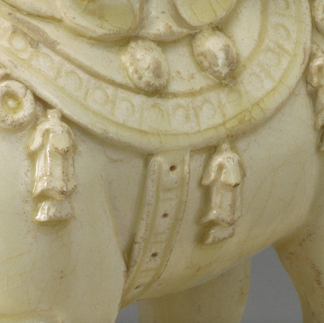唐代筆記 Vol.6 初唐1916萬白瓷大象燭台與東京富士美術館初唐大象 - Two Tang Dynasty White-Glazed ‘Elephant’ Candle Stand, and the Tokyo Fuji Collection.
- SACA
- Jul 8, 2024
- 10 min read
富士美術館的中國藝術收藏中有一件十分特殊罕見的大象燭台,年代確認為唐代,與2016年6月1日佳士得香港售出的1916萬港元唐代大象燭台一致。這類作品是唐代風格的展現,作為陶瓷雕塑,這兩件大象毫無疑問代表了初唐白瓷的高超技藝和審美水平。
東京富士美術館是一個非常低調的美術館,其收藏品涵蓋東西方古美術,水平極高。1981年奠基,1983年對外開館。沒有太多宣傳,一直默默地購藏。藏品大約有3萬件作品,涉及日本、東方、西方的各國各時代的繪畫、版畫、攝影、雕塑,陶瓷、漆工、武器、刀劍、獎章等各種類型的藏品。
SACA學會曾撰文介紹富士美術館的中國藏品:
Tokyo Fuji Art Museum is a very low-profile art museum, its collection covers the East and West ancient art, with high standard, the foundation stone was laid in 1981, and the museum was opened to the public in 1983. There is not much publicity, and the museum has been acquiring artworks quietly ever since. The collection consists of about 30,000 pieces of works, including paintings, prints, photographs, sculptures, ceramics, lacquer work, weapons, swords, medals, and other types of collections from Japan, the East, and the West from all eras.
The Fuji Art Museum's Chinese Art Collection includes a very special and rare elephant candlestick, which has been dated to the Tang Dynasty and is consistent with the Tang Dynasty elephant candlestick sold on 1 June 2016 by Christie's Hong Kong. This type of work is an embodiment of the techniques and aesthetics of the Tang dynasty and has a very special existence as a ceramic sculpture.
一、富士美術館唐代白瓷大象
白磁象形燭台Candle Stand in Shape of Elephant, White Porcelain
唐(7世紀)/
高27.3cm、幅30.9cm、奥行18.7cm
SUMMARY作品解説
這是一件很少有同類的作品。 主體為大象形狀,背面有六個圓柱形燭台。 底座為長方形,周圍環繞著蓮花瓣。 象身上裝有各種裝飾品,象背上鋪有圓形地毯。 白瓷生產始於 6 世紀晚期的河南鞏義窯和河北邢窯,但直到 8 世紀晚期才完成。 根據蓮瓣和白瓷釉池的風格和形狀,這件作品被認為是唐代早期(7 世紀晚期)的作品。 燭台周圍的大象形象、基座和蓮花瓣給這件作品增添了濃厚的佛教色彩。
類例の少ない作品である。本体を象の形に作り、背に6本の筒型のロウソク立てを備えている。台座は長方形で、台座の周りには蓮弁を巡らせている。象の体には様々な飾りが取り付けられ、背には丸いカーペットの敷物が敷かれている。白磁は6世紀後半、河南省鞏義窯や、河北省邢窯で本格的に生産が始まったが、その完成は8世紀後半である。この作品の年代は蓮弁の様式や造形、白磁の釉溜まりなどからみて、唐時代前期、7世紀後半の作と考えられる。象の姿、台座、ロウソク立てに巡らされた蓮弁など、仏教的要素が強く感じられる作品である。
It is a work of few analogues. The body is made in the shape of an elephant with six cylindrical candlesticks on the back. The base is rectangular and is surrounded by lotus petals. The elephant's body is fitted with various ornaments and its back is covered with a round carpet rug. White porcelain production began in earnest in the late 6th century at the Sclayi kilns in Henan province and the Xing kilns in Hebei province, but was not completed until the late 8th century. Based on the style and shape of the lotus petals and the white porcelain glaze pool, this piece is thought to date from the early Tang dynasty, the late 7th century. The elephant figure, pedestal and lotus petals around the candlestick stand give the work a strong Buddhist feel.
二、佳士得2016年初唐白瓷大象
PROPERTY FROM THE CHINHUATANG COLLECTION
隋/初唐 白釉象形燭臺
SUI-EARLY TANG DYNASTY, 6TH-7TH CENTURY
隋/初唐 白釉象形燭臺
12 in. (30.5 cm.) long
來源
台灣德馨書屋珍藏,購於1994年
金華堂珍藏
成交價
港元 19,160,000
估價
港元 5,000,000 – 港元 8,000,000
2016年6月1日
拍品專文
此件象形燭臺塑造生動,裝飾華美,釉色盈潤,是早期白瓷中極其珍罕的煌煌巨製。其以寫實的手法再現了亞洲象隆起的額頭,褶皺的耳朵,以及腿部肌肉結構等特徵,刻畫細緻入微。更為特殊的是,這件象形燭臺的象牙上方各加刻有兩道凸線。此一特徵亦可見於坎薩斯市納爾遜阿特金斯博物館收藏的一件與本件拍品幾乎一致的象形燭臺(圖一),發表於「Art of Asia Acquired by North American Museums 1976-77」,《Archives of Asian Art》, 第31期, 1977-78年,122頁,圖22以及東京根津美術館藏一例,載於1988年東京出版,《唐磁:白磁、青磁、三彩》,編號22,或與佛教中的六牙白象有關。
白象在佛教中象徵擁有大勢卻性善柔和的高貴品質。六牙白象是普賢菩薩之坐騎,更與佛祖釋迦牟尼「乘象入胎」的故事相關。法苑珠林十四千佛篇引因果經云:「爾時菩薩欲降母胎,即乘六牙白象發兜率宮,無量諸天作諸妓樂,燒眾名香,散天妙華,隨菩薩滿虛空中,放大光明,普照十方,以四月八日明星出時,降神母胎」。東魏楊衒之在其《洛陽伽藍記》一書中追述北魏洛陽的「行象」活動時說:「作六牙白象負釋迦在虛空中。莊嚴佛事,悉用金玉。工作之異,難可具陳。四月四日,此像常出,辟邪師子導引其前。吞刀吐火,騰驤一面;綵幢上索,詭譎不常。奇伎異服,冠於都市。像停之處,觀者如堵,迭相踐躍,常有死人。」所謂「行象」就是佛教信徒於每年四月舉行的盛會,慶祝釋迦牟尼佛誕辰日(四月八日)。以六牙白象負釋迦在虛空中象徵著菩薩乘六牙白象騰空而來,正念入胎的故事,因此是整個佛誕日慶典中最核心的一種儀式。
六朝至隋代佛教昌盛,伽藍遍立。上至王公貴冑,下至平民百姓,無不信佛。而佛教信仰也在當時的藝術中打下了深刻的印記。南北朝時期瓷器上最重要的裝飾母題蓮紋即為佛教中象徵聖潔的標誌。蓮紋在本件象形燭上亦占有顯著地位,本件六牙白象立於蓮花座上,背馱一扁圓罐置於一小蓮花座上,罐上有一片荷葉,內生出六枝蓮花承托燭座。《普賢觀經》說六牙白象之六牙表六度,即布施、持戒、忍辱、精進、禪定、般若這六種通向彼岸的方法,象背上蓮花和燭臺之數似也有契合六度之寓意。北齊《玉燭寶典》有載:「四月七日,京師諸像皆來此寺,尚書祠曹錄像凡有一千余軀。」則佛誕日慶典除行象外還有將城中諸像集中供奉的傳統。本品很有可能就是當時在佛誕日慶典中於佛前燃燭供奉所用的。
儘管象早在商周時期的藝術中就有所表現,然而以陶瓷製作白象在隋朝以前都是可望而不可及的。蓋因早期瓷器的胎釉中皆有不同程度的鐵含量,導致無法燒造純淨的白瓷。至公元六世紀,高溫燒造的白胎透明釉瓷器在北方首次出現,其中製作精良者已與後世科學定義的瓷器(porcelain)無異,為陶瓷史上里程碑式的重大突破。值得一提的是,高溫白瓷在創燒之初就已經具備了高度發達的器形和紋飾。隋白瓷的器形兼備諸如本件象形燭臺這樣的複雜雕塑和諸如西安隋大業六年姬威墓出土蓋罐那樣以線條取勝,不假藻飾的極簡器形。技術的先進性和藝術語言的豐富性顯示了隋代白瓷的崇高等級。
除上述納爾遜阿特金斯博物館以及根津美術館藏兩例外,同類背馱六朵蓮花承燭座的象形燭台在全世界公私收藏中僅見其它三例:倫敦埃斯肯納齊行曾展出一例,現藏瑞士玫茵堂,著錄於Regina Krahl著,2006年倫敦出版,《玫茵堂藏中國陶瓷》,圖錄編號1184(圖二); 其餘二件相似的象形燭臺的蓮花座為橢圓形,鞍鞯飾有花邊,包括上海博物館藏一例,載於《文物》,1957年,第8期,73頁;以及Goldschmidt舊藏一例,出版於Otto Kümmel著,1930年柏林出版,《Jörg Trübner zum Gedächtnis. Ergebnisse seiner letzten chinesischen Reisen》, 圖74,是例後於紐約蘇富比拍賣,2001年9月19日,拍品編號96。Goldschmidt舊藏有另一件象形燭台,背負一胡人抱柱,上承蓮花形燭座,見前揭書,圖75,該例後於紐約蘇富比拍賣,1998年3月24日,拍品編號571。另有一類尺寸較小、細節較少的白釉象形燭臺,可參照1980年紐約出版《Treasures from the Rietberg Museum》,圖錄編號46及46a,前者藏於蘇黎世Rietberg博物館,後者為大英博物館收藏。
此器經牛津熱釋光測年法檢測 (測試編號PH 015/234),證實與本圖錄之定年符合。
AN IMPORTANT AND VERY RARE WHITE-GLAZED ‘ELEPHANT’ CANDLE STAND
SUI-EARLY TANG DYNASTY, 6TH-7TH CENTURY
Price realised
HKD 19,160,000
Estimate
HKD 5,000,000 – HKD 8,000,000
Closed:
1 Jun 2016
DETAILS
AN IMPORTANT AND VERY RARE WHITE-GLAZED ‘ELEPHANT’ CANDLE STAND
SUI-EARLY TANG DYNASTY, 6TH-7TH CENTURY
The candle stand is powerfully modelled as a caparisoned elephant standing foursquare on a rectangular lotus plinth, with its trunk touching the ground and its head wearing an elaborate harness with roundels and leaf-shaped pendants. The rounded back is covered with a circular saddle cloth set with a lotus flower, richly decorated with florettes and bells, all secured with studded straps under the chest, torso and tail, supporting on its back a compressed globular jar covered with a lotus leaf. Emerging from inside the jar are six floral stalks, each supporting a tubular receptacle. It is covered overall with a finely crackled clear glaze with a slight lime-green tinge with the exception of the base revealing the fine white body.
12 in. (30.5 cm.) long, stand, box
PROVENANCE
The Dexinshuwu Collection, Taiwan, acquired in 1994
Lot Essay
White-glazed candle stands modelled as large elephants are the rarest and most impressive example of early white wares. The present example is distinctive among all other known examples for the sophistication in its modelling and its well-preserved lustrous glaze. The naturalistic depiction of protruding humps on the forehead, wrinkled ears, and clearly defined muscle structure on the legs successfully represents an adult Indian elephant. It is interesting to note the indentations above each side of the elephant’s tusks, which seem to deviate from a realistic depiction of an elephant. This feature can also be found on an almost identical piece in the Nelson-Atkins Museum, Kansas City, illustrated in ‘Art of Asia Acquired by North American Museums 1976-77’, Archives of Asian Art, no. 31, 1977-78, p. 122, fig. 22 (fig. 1) and a very similar piece in the collection of Nezu Museum, illustrated in Tang Pottery and Porcelain, Tokyo, 1988, no.22. This unusual depiction can possibly be explained by the iconographic reference to the six-tusk white elephant in Buddhism.
The white elephant is revered in Buddhism as a symbol of strength and high morality. The six-tusk white elephants in particular represent the vehicle of the Bodhisattva Puxian (Samantabhadra) and are associated with the birth of the Buddha Shakyamuni. According to Buddhist tradition, Buddha Shakyamuni’s mother Queen Maya, once barren, became pregnant after dreaming of a Bodhisattva riding a six-tusk white elephant entering her womb. The Eastern Wei gazette on Buddhist monasteries, Luoyang qielan ji, recorded the Buddhist ritual xingxiang (parade of statues) in the Northern Wei capital Luoyang: 'a caparisoning six-tusk white elephant to lift Buddha Sakyamuni into the air. On the 4th day of the fourth mouth, the statue is brought out. It is guided by bixie and lions and escorted by men swallowing knifes and spitting fire0. Wherever it stops, the spectators are packed like walls so that people die due to the stampede.' (See Jia E, ‘Shuo Han Tang jian baixi zhongde xiangwu’, Wenwu, Beijing, 1982, vol. 9, p.56) During that period, the xingxiang ritual was performed by many monasteries in the fourth month of each year to commemorate the birthday of Buddha Shakyamuni (8th day of the fourth month). (See ibid, pp.56-57) The use of caparisoned six-tusk elephant as a mount or a supporting vehicle for a Buddha statue is metaphoric of Shakyamuni’s birth story and therefore is central to all the ritual performances in the Buddha’s birthday celebration.
The Six Dynasties (220-589 AD) and the Sui Dynasty (581-618 AD) were the pinnacle of Buddhist development in Chinese history. During this period, Buddhism was widely practised from the ruling elite to commoners and as such had a heavy influence on the arts. Lotus, the Buddhist symbol of purity, and of Buddhism in general, was the dominant decorative motif on ceramics of the Northern and Southern dynasties. In fact, the lotus is also the most important motif on the present piece. The elephant is standing on a lotus plinth and six candle holders are set on six lotus blooms growing from the jar. The Bodhisattva Samantabhadra Sutra mentions the six tusks of Samantabhadra’s white elephant represent six pāramitās, which may explain the number of candle sockets on the elephant’s back. The iconography of white elephant and the use of lotus motif on the white-glazed ‘elephant’ candle stands such as the present example indicate that they were made for actual use in Buddhist rituals, particularly during celebrations of the Buddha’s birthday.
The representation of white elephants in ceramics first appeared possibly in the late 6th century when high-fired white stoneware was came to prominence in Northern China. This was an important step forward in Chinese ceramic history. The repertoire of early white wares included both complicated sculptural forms such as the present example and minimalistic forms such as the covered jar found in the tomb of Jiwei in Xian, Shaanxi province (dated to 610 AD), illustrated in Masahiko Sato and Gakuji Hasebe, Ceramic Art of the World, vol. 11: Sui and Tang dynasties, pl. 10. The technological advancement and sophistication of early white ceramics indicate a high status of these wares. The most famous of the kilns producing early white wares were those of Xing in Hebei province (modern day Lincheng), Xiangzhou in Henan province (modern day Anyang), and Gongxian also in Henan. The exact kiln for the present elephant candle stand has yet to be identified as none of these cited kiln sites as yet yielded shards that can be related to this group. Nevertheless this magnificent ‘elephant’ candle stand has all the qualities we would expect of a religious ware intended for important aristocrats or the imperial family.
Except for the Nelson-Atkins Museum and the Nezu examples cited above, there are only three other candle stands of this type, with the elephant carrying a jar with six lotus flowers. A very similar example was exhibited in Ceramic Sculpture from Han to Tang China, Eskenazi Ltd., New York, 1997 and now in the Meiyintang Collection housed in the Rietberg Museum, Zurich, discussed and illustrated by Regina Krahl in Chinese Ceramics from the Meiyintang Collection, London, 2006, Catalogue, no. 1184 (fig. 2). The others with foliate-bordered saddle cloths and oval plinths are in the Shanghai Museum, published in Wenwu (Cultural Relics), 1957, no. 8, p. 73; and from the Goldschmidt Collection, illustrated in Otto Kümmel, Jörg Trübner zum Gedächtnis. Ergebnisse seiner letzten chinesischen Reisen, Berlin, 1930, pl. 74 and was sold at Sotheby’s New York, 19 September 2001, lot 96. The Goldschmidt Collection included another closely related white elephant candle stand, but with a figure of foreigner clasping the single lotus-shaped socket, illustrated ibid., pl. 75 and sold at Sotheby’s New York, 24 March 1998, lot 571. Other elephant candle stands of similar dating are much smaller and more stylised. Compare two such pieces illustrated in the Treasures from the Rietberg Museum, New York, 1980, Catalogue, no. 46 and fig. 46a.
The result of Oxford Authentication thermoluminescence test no. PH 015/234 is consistent with the dating of this lot.































Comments